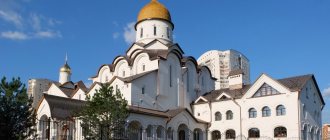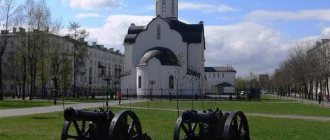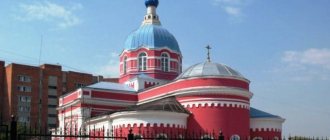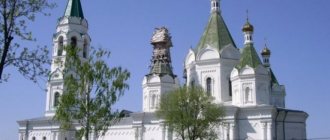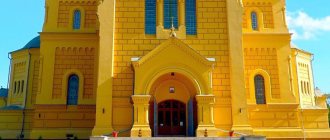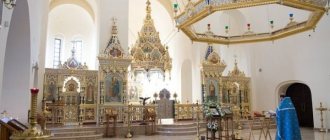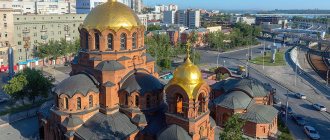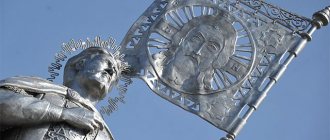History of the construction of the Alexander Nevsky Temple in Zelenograd
In 2012, the foundation stone was consecrated at the construction site of the temple in honor of the holy noble prince Alexander Nevsky.
Construction began in the area of the former village of Aleksandrovka, in the 14th microdistrict of Zelenograd, and was erected on the site of bloody battles in the December days of the Battle of Moscow 1941.
On October 31, 2013, while digging a trench, next to a temple under construction, an artillery shell was discovered. A brigade of sappers was called and found that this was a shell from the Great Patriotic War in combat condition.
The shell was removed, and the area adjacent to it was examined by sappers using special equipment and only then was permission given to continue the work.
On January 2, 2021, on the day of the Temple Feast of St. Righteous John of Kronstadt, the first Liturgy took place in the church under construction.
On April 2, 2021, the first Bishop's service took place in the Alexander Nevsky Church. During this time, the parable house was also built.
The church has a Sunday school for children and adults. The following clubs are open for children: “Lego”, “Sculpture”, “Art Studio”, “Wool Felting”, “Learning to Play the Guitar”.
A series of spiritual meetings “Good evening” is held for adults
In the house of the parable there is a church shop. Volunteer assistance "Chaika" works at the temple
The monument to Alexander Nevsky will be erected in Zelenograd in the first half of May
In Zelenograd they are preparing for the opening of a monument to Alexander Nevsky. It was made by the same sculptor as the monument to Prince Vladimir near the Kremlin walls. The project is being implemented on the initiative and with funds from the NP MZHK "Zelenograd".
Plans to install a monument on the territory of the Alexander Nevsky Temple near the 14th microdistrict were reported back in the fall of 2021. Chairman of the NP MZHK “Zelenograd” Alexander Raptovsky, who is the head of the team of authors and the author of the very idea of installing the monument, told the Infoportal about the details of the project’s implementation.
According to Raptovsky, now the sculpture of Alexander Nevsky is ready and is in the LitART art workshop in Zhukovsky, where it was made. After Easter, celebrated this year on May 2, it is planned to install it on a pedestal next to the temple, after which the monument will be wrapped in a white blanket until the official opening. It is planned to be held from May 15 to June 12. An invitation with a request to take part in the ceremony and consecrate the monument was sent to Patriarch Kirill, with whose blessing Raptovsky began to implement this project. The ceremony is planned to coincide with the 800th anniversary of the birth of Alexander Nevsky, which is celebrated this year. The exact date of birth of the legendary prince is unknown: in particular, the dates given are May 13 and May 30. Patriarch Kirill himself several years ago proposed celebrating this date on June 12, Russia Day, which approximately corresponds to May 30 according to the old style.
Financing of all work on the creation of the monument was carried out from its own funds by the non-profit partnership MZHK "Zelenograd", which also acts as the general contractor and main investor in the construction of the Alexander Nevsky Temple near the 14th microdistrict. The sculptor Salavat Shcherbakov, People's Artist of Russia, who is also the author of the sculpture of Prince Vladimir on Borovitskaya Square near the Kremlin walls, and the architect Alexey Kharchenko worked on the creation of the monument, and the author of the idea, compositional solution and historical detailing of the sculpture was Alexander Raptovsky himself. Vladimir Saprykin and Alexey Dubin, who together with Raptovsky are the authors of the sculptures of the little mermaid, a boy on a bicycle and a turtle in the MZHK, also participated in the development of the monument’s layout.
Video courtesy of Alexander Raptovsky
For Raptovsky himself, participation in the creation of a monumental sculpture was a completely new experience. According to him, before starting work, he looked at all the monuments to Alexander Nevsky in Russia. “I studied how and what they are made of. I didn't want to repeat myself. This allowed me to understand what I wanted and determine the composition. I realized that I perceived the prince as a young man of about 25 years old who had already undergone baptism of fire. He leaves the temple, stands in the square in front of his army, gathering for the next battle, and makes a speech to his comrades. This is the connection with the temple,” said Raptovsky.
Project of a monument to Alexander Nevsky. Images from the page of the Alexander Nevsky Temple on VKontakte
Alexander Raptovsky also noted that while working on the project, he re-read the biography of Alexander Nevsky and studied historical documents, since it was important for him to achieve good detail and at the same time avoid “cinema cliches and historically unreliable elements.” “It is clear that we do not have exact information about what Alexander Nevsky looked like - this is just some kind of Slavic image of a young warrior. But we were able to understand what the helmet, chain mail, armor, sword, cloak, fasteners, shape of the banner should be like... What icon could be used on the banner - as a result, the image of the Savior Not Made by Hands was placed there,” explained Raptovsky, adding that on It took about six months to develop and create the 70 cm high model.
Details of the sculpture. Photos courtesy of Alexander Raptovsky
To determine the location of the monument, another life-size cardboard model was made, which was moved around the temple until the optimal location was chosen. The height of the bronze figure is 2.7 meters, with a banner - 4.5 meters. The sculpture will be installed on a granite pedestal 1.65 meters high.
The image of the monument, which will be installed in Zelenograd, was used in public service advertising dedicated to the 800th anniversary of the birth of Alexander Nevsky, noted Alexander Raptovsky. You can see posters with this image on the streets of the city.
Poster depicting the monument to Alexander Nevsky on Yablonevaya Alley. Photo of the Infoportal
Let us add that in 2021, during the consecration of the Alexander Nevsky Temple, Patriarch Kirill presented Alexander Raptovsky with the Order of the Holy Blessed Prince Daniel of Moscow, III degree, for his active participation in the construction of the temple.
On this topic
Visit to the temple
The first time I went there was on Palm Sunday. Of course, it was necessary to visit when there were few people there, but I really wanted to see the decoration of the temple inside. Naturally, I only saw a crowd of people standing behind the palm trees
branches.
This surprised me; it was the first time I had seen that palm branches were distributed on Palm Sunday. Grandma always went to illuminate the willow branches.
I, as a person with a pioneer-Komsomol atheistic upbringing, could not understand why there were palm branches in this Temple. I had to look for information.
Palm Sunday stands out from the general style of Lent. On this day, Christ entered Jerusalem and people from this city and the entire surrounding area greeted him as the Messiah and threw palm branches at his feet. Palm branches are the most famous symbol in ancient times; this is how kings who returned home with victory were honored. Since palm trees do not grow here, we bring other branches that bloom at this time - willow, but the point is not whether it is a willow or a palm tree, the point is how we meet Christ: as a King not of this world, as the Conqueror of death as the Son of God.
This is how I learn, bit by bit, what I didn’t know for many years.
The next time I went to light candles for the repose of my relatives and I really liked the decoration inside.
I also liked the fact that the church supplies store there is located separately from the temple itself.
The room is quite large, you can see what is there calmly, without crowding. I was interested in the fact that the seller has a computer, it’s modern, you can’t say anything!
There weren't many people in the temple itself, which I always like. You can just stand and think. look at the icons without disturbing the peace of the parishioners with your presence. Everyone has their own thoughts, requests, prayers.
For some reason this snow-white temple caught my attention. Now I know there is a place to think about your life. I think that I will come here. In the meantime, I’ll share the address:
Address:
st. Alexandrovka, 1A, Zelenograd
Telephone:
+7 499 404‑00-02
How to get there:
from Kryukovo station take buses 16 and 16k to the Fire Station stop
Sights of Zelenograd – TOP-3
Memorial complex "Bayonets"
- Address: Matushkino village.
The grandiose memorial complex includes a mass grave and a monument to the Defenders of Moscow. It owes its name to the shape of the central obelisk, which is a stylized image of three bayonets.
The first burials in a mass grave took place during the war, after the Battle of Moscow. In 1941-1942 soldiers who died near the village of Matushkino were buried here. In the 1960s The remains of soldiers found during the construction of Zelenograd were lowered into the grave. Currently, 760 people are buried in the memorial.
The memorial complex was opened in 1974. It has the status of a cultural heritage site of regional significance. The image of “Bayonets” became one of the elements of the coat of arms of Zelenograd, Moscow region.
"Vedogon-theater"
- Address – Yunosti, 6.
It is organized in the former city cinema. The founder was Honored Artist of the Russian Federation Pavel Kurochkin. It was he who came up with the original concept of the theater. “Vedogon” is translated from Old Church Slavonic as “spirit of a living being.”
This means that artists on the theatrical stage strive to awaken the creative spirit in their viewers. The repertoire includes modern and classical works. These productions have won numerous festivals and competitions.
The Vedogon Theater has its own stage, an auditorium with 104 seats, as well as a new stage area for the implementation of unusual projects and creative exhibitions.
Chapel of Lazarus the Fourth Day
- Address: Serednikovskaya, 19-2.
The chapel was built in 1998 on the initiative of the city administration. It was consecrated in honor of the righteous Lazarus of the Four Days, who, thanks to the great miracle of the Savior, was resurrected on the fourth day after death.
The church is located at the entrance to the Rozhki cemetery. It was built in the style of Novgorod-Pskov architecture of the 14th-15th centuries. The tall, light building is surrounded by greenery. The inside of the chapel is decorated with icons. Funeral services and memorial services for the deceased are held there.
Zelenograd parks and squares
Zelenograd fully lives up to its name. It is simply surrounded by greenery. It's all the fault of the valiant city planners. They took great care of the forests growing in the surrounding area.
City Forest Park
It occupies approximately 120 hectares. The vast territory amazes with its order and cleanliness. It includes Victory Park, decorated with a cascade of fountains, and a wide alley, picturesquely descending to the pond. There are recreation areas, playgrounds, and places for the whole family to walk. Citizens enjoy relaxing in this park.
Mikhailovsky Pond
This is the most popular place in the area. Various public events are held here, City Day is organized, etc. Mikhailovsky Pond is visited on weekdays and holidays to enjoy the clean air and picturesque views.
The reservoir occupies almost a hectare. Its depth is about two meters. It got its name in honor of the village of Mikhailovka, next to which it is located. Has two reaches. They are connected by a small strait, across which there is a stone bridge.
Children's auto town
- Address: 10th microdistrict.
Appeared in 2007 on the shore of Shkolnoye Lake. It is a kind of mini-city with a children's highway. There are traffic lights, intersections, winding paths and even gas stations. Children can take a ride in a small electric car and learn all the intricacies of traffic rules.
The motor town was created with the aim of teaching children the basic rules of the road. It employs young traffic controllers who tell the meaning of road signs. Vehicle markings have been applied to the roadway. Everything follows the rules of an ordinary adult road. But real cars are prohibited from entering here.
You can also find other entertainment in the park: rent bicycles and rollerblades, jump on a trampoline, or just sit on a bench among the greenery. There are areas for sports here. You can swim and fish at the nearby lake.
Victory Park
It is part of the city forest park. It was reconstructed in 2019. Very popular among citizens and guests of the city.
The park opened in 1985. This event was timed to coincide with the anniversary of the Second World War. A little later, a bust of Marshal Rokossovsky, a military leader under whose command the defense of the approaches to Moscow in the Zelenograd area, was installed.
The park has a terraced layout. It descends in steps from the central square to the large city pond. After reconstruction, the embankment of the reservoir was cleared, paved, flower beds were laid out, and benches were installed.
The pond was equipped with fountains in the form of water lilies. A boat station also appeared here. Now 12 boats can moor to the shore at the same time.
Park Rovesnik
A very cozy park. Opened in 2011. Situated on seven hectares. It is a great place to relax with the whole family. There is a city court, bicycle parking, and children's playgrounds. The park is adapted for recreation for people with disabilities. In the center there is a monument dedicated to people who died while performing military duty in peacetime.
Sculpture Park
This is an alley in the ninth microdistrict of Zelenograd. There is a large collection of limestone sculptures here. The authors of the works were 10 sculptors - they created the popular compositions “Girl with a Dog”, “Architect” and others. The material for the sculptures was brought from Voskresensk. The figures fit perfectly into the park landscape. You can touch them and take pictures.
